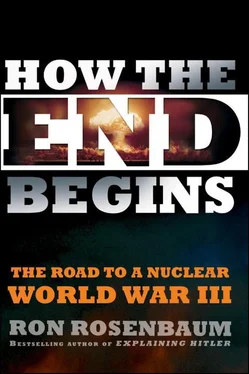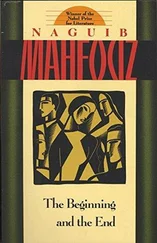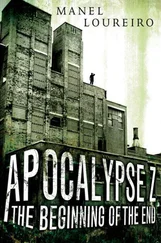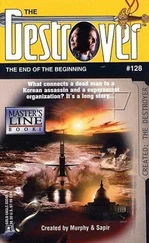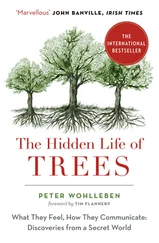Ron Rosenbaum
HOW THE END BEGINS
The Road to a Nuclear World War III
To Major Harold I. Hering (ret.)
For the courage to question
“Please don’t let it happen. But let me see it all the same, as it’s happening and from every angle, and let me be among the first to know.”
—FROM IAN McEWAN’S
SATURDAY
KENT: Is this the promised end?
EDGAR: Or image of that horror?
—
KING LEAR
“It is an act of evil to accept the state of evil as either inevitable or final.”
—RABBI ABRAHAM JOSHUA HESCHEL
CHAPTER ONE
“WE CAME SO CLOSE”
The London-based Spectator is the oldest continuously published periodical in the English language, dating back to eighteenth-century London coffeehouse literary culture. [1] Founded in 1711 by Richard Addison.
It has survived as a respected general interest weekly, politically eclectic, culturally snobbish in a louche Old Etonian way, with highly regarded sources from within the old boy network in the leading British ministries.
But it rarely discloses anything as sensational and chilling as it did in the opening paragraphs of an article in the October 6, 2007, issue. It stopped me dead. It was not just the invocation of the jolting phrase “World War Three.” It was the deadly serious way in which it was invoked.
In most of the post–Cold War period, the so-called “holiday from history” [2] George Will, “The End of Our Holiday from History,” Washington Post, September 12, 2001, Opinion Section, p. A31.
when many succumbed to a historical amnesia about the dailiness of nuclear dread, the term “World War Three” has had a ring of unreality. It usually sounded or read like an antiquated paranoid fear from a half-remembered past, the way we feel when we read of the “Black Plague,” a relic of the bad old days that still nonetheless conveys a ghostly chill. We were worried about nuclear terrorism in 2007, but not nuclear war. Nuclear war: so retro.
But here, in these Spectator paragraphs anyway, nuclear war, “World War Three,” was something that had almost just happened:
“SO CLOSE TO WAR” [3] James Forsyth and Douglas Davis, “We Came So Close to War,” The Spectator, September 20, 2007, online edition; October 6, 2007, print edition.
We Came So Close to World War Three That Day
James Forsyth and Douglas Davis
6 OCTOBER 2007
On 6 September, when Israel struck a nuclear facility in Syria…
The article described what it called a “meticulously planned, brilliantly executed surgical strike by Israeli jets on a nuclear installation in Syria.” [4] Ibid.
It claimed the raid “may have saved the world from a devastating threat. The only problem is that no one outside a tight-lipped knot of top Israeli and American officials knows precisely what that threat involved.” The article went on to say that this report has been confirmed by a “very senior British ministerial source,” who’d said: “If people had known how close we came to world war three that day there’d have been mass panic. Never mind the [seasonal] floods or foot-and-mouth [disease]—[Prime Minister] Gordon [Brown] really would have been dealing with the bloody Book of Revelation and Armageddon.”
There is no doubt, as was later confirmed, [5] as was later confirmed: “Background Briefing with Senior U.S. Officials on Syria’s Covert Nuclear Reactor and North Korea’s Involvement,” Office of the Director of National Intelligence, April 24, 2008, www.dni.gov/interviews/20080424_interview.pdf .
the raid happened. But how close did it bring us to World War Three? The question was a wake-up call, the return of the repressed—“the bloody Book of Revelation and Armageddon.” We thought we had left that all behind.
But one could not read the story without war-gaming concatenations of regional nuclear wars that might cascade, through miscalculation or misperception, into global conflagration from such a close call.
It was not inconceivable.
Consider: the raid began with Israeli jets taking off after dark and proceeding north toward the northeast corner of Syria, toward a bleak barely habited stretch of land near the Euphrates. Subsequent reports indicated that electronic countermeasures (ECMs) [6] David A. Fulghum, “Why Syria’s Air Defenses Failed to Detect Israelis,” Aviation Week, October 3, 2007, www.aviationweek.com/aw/blogs/defense/index.jsp?plckController=Blog&plckBlogPage=BlogViewPost&newspaperUserId=27ec4a53-dcc8-42d0-bd3a-01329aef79a7&plckPostId=Blog:27ec4a53-dcc8-42d0-bd3a-01329aef79a7Post:2710d024-5eda-416c-b117-ae6d649146cd&plckScript=blogScript&plckElementId=blogDest (accessed 4/15/10).
were used by the Israelis to blind Syrian radar and antiaircraft installations as the planes crossed the border and approached their target.
Their target, later identified [7] Background Briefing, with Senior U.S. Officials.
as a not yet operational nuclear reactor modeled on the Yongbyon reactor in North Korea—a uranium-fueled reactor that is capable of producing weapons-grade plutonium as a by-product—was destroyed. But the action could have triggered dangerous consequences. For one thing, the former Soviet Union, as well as the United States, is known to have satellite look-down capacity focused on trouble spots. There is little doubt the Russians would have picked up the Israeli jets’ takeoff and—in the context of threats and counterthreats exchanged between Iran and Israel over the Iranian nuclear weapons program—they may well have warned the Iranians, with whom they have murky military and nuclear ties, that a potential Israeli attack on their nuclear facilities was under way. The Russians could easily have fired off an electronic warning to the Israelis not to attack Iran—and/or Syria—and implicitly or explicitly threatened “severe consequences” or some other euphemism for putting nukes on the table.
The Soviets, for instance, [8] Georgetown University Library National Security Archives, www.gwu.edu/~nsarchiv/NSAEBB/NSAEBB98/press.htm (accessed 4/15/10).
are reported to have sent an indirect nuclear warning to the Israelis at least once before—at the close of the 1973 war when the Israeli army was threatening to crush the Egyptian Third Army, the last barrier before Cairo. They dispatched an aggressive note to the United States warning of intervention if Israel persisted, which led the U.S. to raise its nuclear alert status to DEFCON-3 before Israel backed off. In other words, the Russians may have invoked that night what is known as a “nuclear umbrella”—or as U.S. nuclear savants more euphemistically call it, “extended deterrence”—in which a nuclear power uses nuclear threats to deter attacks against a nonnuclear ally.
Israel of course, though it has still not acknowledged it officially, is a substantial nuclear power [9] Jane’s Defence Weekly, April 10, 2010, www.janes.com : Israel estimated to have “100 to 300 nuclear warheads and has a power similar to that of Britain.”
with as many as two hundred warheads at its disposal, according to some estimates. Shortly after the Cold War, journalist Seymour Hersh reported [10] Seymour Hersh, The Samson Option: Israel’s Nuclear Arsenal and American Foreign Policy (New York: Random House, 1991).
that it had targeting contingency plans, which included sites in the Soviet Union in preparation for a retaliation should such a Soviet threat have been carried out.
Читать дальше
